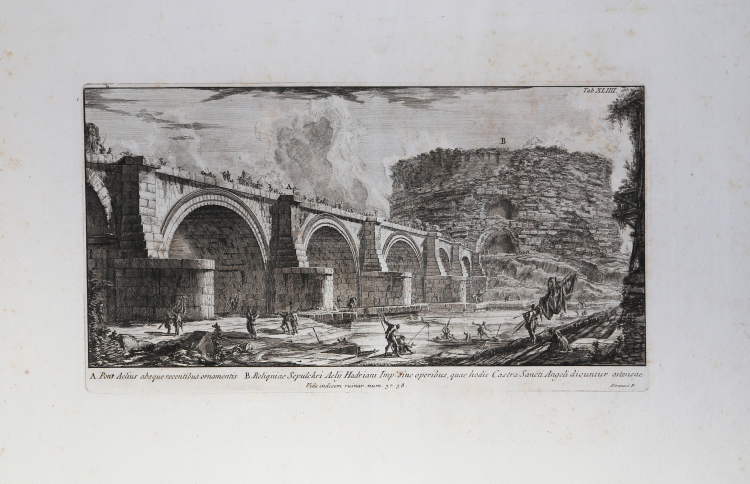



| Reference: | s22156 |
| Author | Giovan Battista PIRANESI |
| Year: | 1762 |
| Zone: | Campo Marzio |
| Printed: | Rome |
| Measures: | 400 x 220 mm |


| Reference: | s22156 |
| Author | Giovan Battista PIRANESI |
| Year: | 1762 |
| Zone: | Campo Marzio |
| Printed: | Rome |
| Measures: | 400 x 220 mm |
A fantastic view from Il Campo Marzio dell'Antica Roma.
A fine impression from the early roman edition, printed on contemporary laid paper with "double encircled fleur de lys" watermark, wide margins, in very good conditions.
Altought published in 1762, the genesis of this ambitious work extended back into the previous decade.
Significantly, as an exercise in speculative archaeology executed with contemporary architects in mind, the work originated in the highly productive relationship between Piranesi and Robert Adam. Not only was the folio dedicated to the British architect, but much of its material was assembled during Adam's studies with Piranesi in Rome between 1755 and 1757.
According to the considerable dedicatory preface, the author's objective was to examine the customs and environment of a vanished society through the study of its architectural remains.
The end product was a remakable series of hypothetical reconstructions, presented in plan, elevation, and perspective, in which Piranesi's imaginative faculties were stretched to the full.
Il Campo Marzio opens with 33 pages of learned discussion of literary authorities with parallel text in Latin and Italian. There follows a group of maps showing, stage by stage, the evolution of this site from primitive beginnings in the marshy site bounded by the curve of the Tiber to a densely monumental townscape of the utmost complexity and grandeur.
The climax is provided by the virtual fantasy of the Ichnographia, a vast six-plate purportedly representing the Campus Martius under the empire. The Ichnographia is supported by 37 plates of vedute and detailed surveys in which Piranesi presented the raw material on which this speculative act was based, often using the cramatic technique of isolating monumental fragments from the accretions of the medieval townscape.
To conclude Il Campo Marzio, Piranesi added for the first time in his antiquarian reconstructions a series of aerial perspective of selected parts of the Ichnographia, including one on the book's second title page. (J. Wilton Ely).
|
Focillon 474; Wilton-Ely 605
|
Giovan Battista PIRANESI (Mogliano Veneto 1720 - Roma 1778)
|
Italian etcher, engraver, designer, architect, archaeologist and theorist. He is considered one of the supreme exponents of topographical engraving, but his lifelong preoccupation with architecture was fundamental to his art. Although few of his architectural designs were executed, he had a seminal influence on European Neo-classicism through personal contacts with architects, patrons and visiting artists in Rome over the course of nearly four decades. His prolific output of etched plates, which combined remarkable flights of imagination with a strongly practical understanding of ancient Roman technology, fostered a new and lasting perception of antiquity. He was also a designer of festival structures and stage sets, interior decoration and furniture, as well as a restorer of antiquities. The interaction of this rare combination of activities led him to highly original concepts of design, which were advocated in a body of influential theoretical writings. The ultimate legacy of his unique vision of Roman civilization was an imaginative interpretation and re-creation of the past, which inspired writers and poets as much as artists and designers.
|
|
Focillon 474; Wilton-Ely 605
|
Giovan Battista PIRANESI (Mogliano Veneto 1720 - Roma 1778)
|
Italian etcher, engraver, designer, architect, archaeologist and theorist. He is considered one of the supreme exponents of topographical engraving, but his lifelong preoccupation with architecture was fundamental to his art. Although few of his architectural designs were executed, he had a seminal influence on European Neo-classicism through personal contacts with architects, patrons and visiting artists in Rome over the course of nearly four decades. His prolific output of etched plates, which combined remarkable flights of imagination with a strongly practical understanding of ancient Roman technology, fostered a new and lasting perception of antiquity. He was also a designer of festival structures and stage sets, interior decoration and furniture, as well as a restorer of antiquities. The interaction of this rare combination of activities led him to highly original concepts of design, which were advocated in a body of influential theoretical writings. The ultimate legacy of his unique vision of Roman civilization was an imaginative interpretation and re-creation of the past, which inspired writers and poets as much as artists and designers.
|